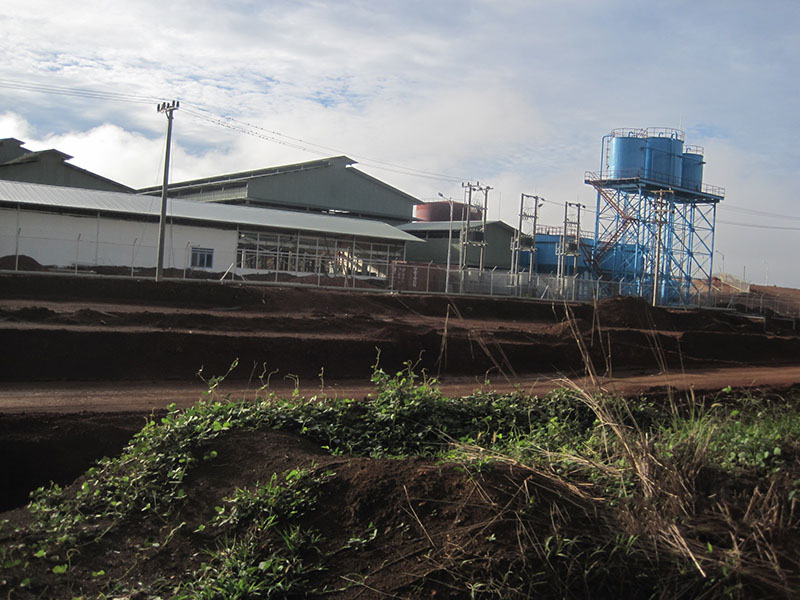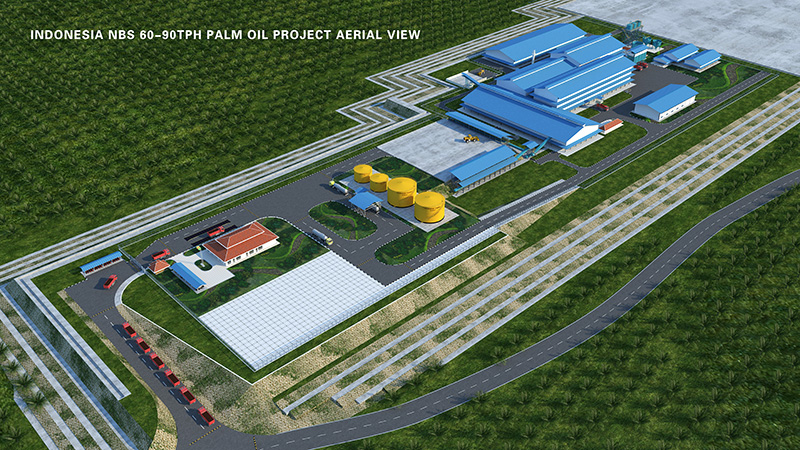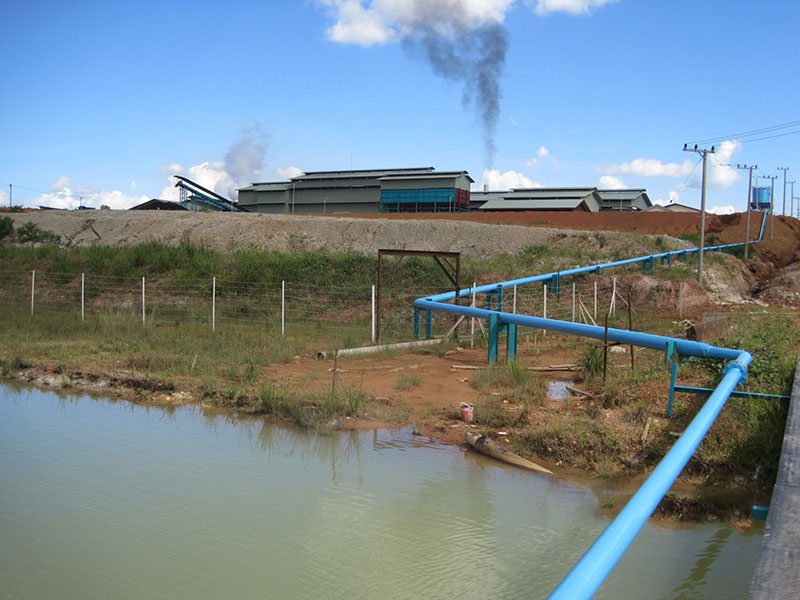Palm oil, as the world's largest vegetable oil, occupies a major position in edible oil and industry. It is currently mainly planted in tropical regions, mainly distributed in Southeast Asia, South America, and West Africa. Among them, Indonesia and Malaysia account for 80% of the world's production, and West Africa and South America have great development space.
Overview of palm oil pressing project: After picking, the fresh fruit bunches (FFB) of palm are sorted and enter the closed container (fermentation tank) for sterilization with high-temperature steam; the ripe fruit bunches (SFB) after high-temperature cooking are repeatedly dropped by the cage drum thresher to separate the fruit grains from the fruit bunches. After the empty fruit bunches (EFB) pass through the empty fruit bunch cutter and the empty fruit bunch press, the remaining residual oil is obtained and the moisture of the empty fruit bunch is reduced, and it is provided as fuel to the steam boiler for the plant area.
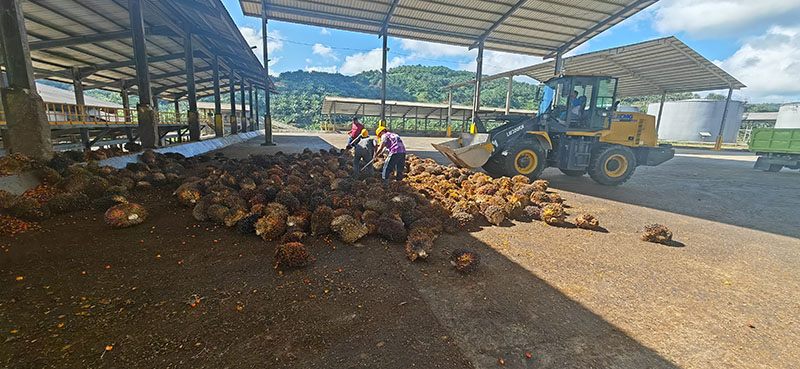
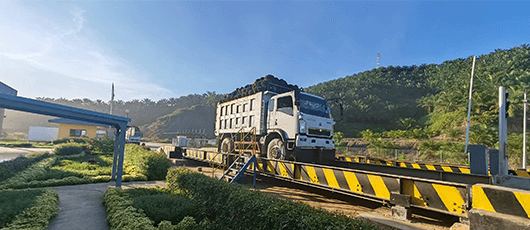
The fresh palm fruit bunches entering the factory are weighed together with the transport vehicles. After unloading, the empty vehicles are weighed again to calculate the net weight of the materials. Main equipment: truck scale and weighing identification calculation system.
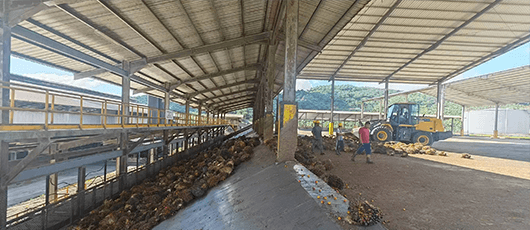
The fresh fruit bunches after unloading are first sorted manually, and the stones, spoiled fruits and debris that do not meet the requirements are cleaned up. These debris will be sent back and deducted from the weight. At the same time, it also ensures that the equipment is not damaged and improves the quality of the oil. The sorted fresh fruit bunches are stacked on the inclined slope by the loader, and enter the fresh fruit bunch conveying scraper through the opening of the hydraulic device door. Main equipment: unloading platform, unloading slope, hydraulic gate, palm fresh fruit bunch scraper conveyor.
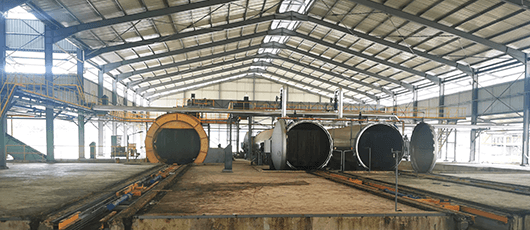
Fresh palm fruit bunches are loaded into the sterilization tank by the scraper conveyor and cooked for 80-90 minutes under high temperature 145℃ steam conditions, thereby reducing the activity of enzymes and inhibiting the increase of free fatty acids (FFA). The quality of palm crude oil is guaranteed and conditions for subsequent processes are provided. The main equipment includes: fresh fruit bunch scraper conveyor, sterilization tank, Indexer control system, and cage tipping car.
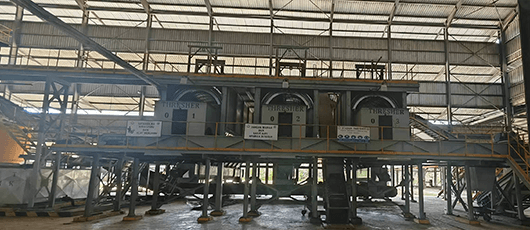
The cooked fruit bunches (SFB) after steaming and sterilization are separated from the palm fruit and empty fruit bunches by drum-type rotary beating.
The empty fruit bunches contain a certain amount of oil and water, which are reduced in water content and residual oil after passing through the empty fruit bunch shredder and empty fruit bunch press. After the size and water content of the empty fruit bunches are reduced, they are transported to the boiler as fuel. Main equipment: empty fruit bunch scraper conveyor, palm fruit threshing machine, empty fruit bunch scraper conveyor, empty fruit bunch shredder, empty fruit bunch press, and rotary vibrating screen.
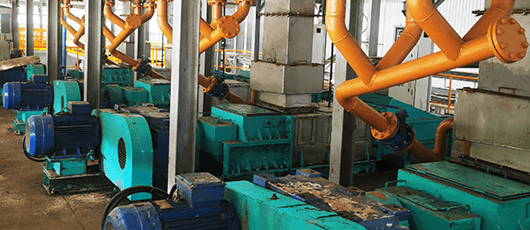
After sterilization and de-fruiting, the fruit particles enter the crushing tank, where the fruit particles are stirred and crushed into a paste state, and steam is used for sterilization at the same time. Then they enter the double-screw press for extrusion, the oil and water are squeezed out, and the pressed cake including the palm kernel and pulp fiber is separated and crushed and spirally conveyed to the next section. Main equipment: screw conveyor, crushing tank, double-screw press, spiral crusher.
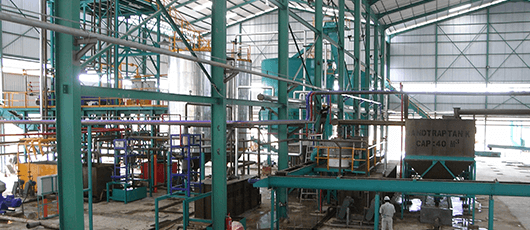
The oil clarification station is to reduce the moisture and impurities in the crude oil after pressing, so that its quality meets the market sales standard. After pressing, the crude oil is filtered, settled, sanded, centrifuged, vacuum dried and other processes to remove moisture and impurities in the palm crude oil. The main equipment includes sand settling tank, double-layer rotary vibrating screen, continuous vertical oil clarification tank, sand clarifier, three-phase horizontal screw centrifuge, disc centrifuge, vacuum dryer, etc.
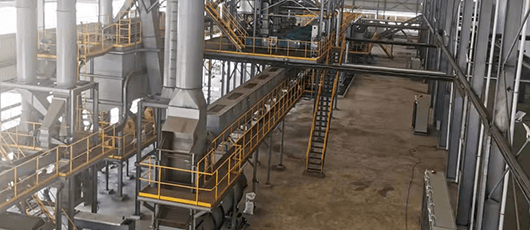
The fiber in the pressed cake is separated and removed, and the kernel shell after the palm kernel is crushed is separated and stored.
The fiber of the cake from the double screw oil press is separated by wind, and the palm kernel is polished, de-stoned, crushed, air-selected, washed and separated to separate the palm kernel and palm shell. The palm kernel and palm shell are dried and stored, and the fiber part is transported to the boiler fuel bunker as boiler fuel. Main equipment: fiber sachets, polishing drums, de-stone separation columns, 1,2-level kernel and shell separation columns, water-washed sachets, kernel drying bunkers, kernel and shell screw conveyors and elevators.
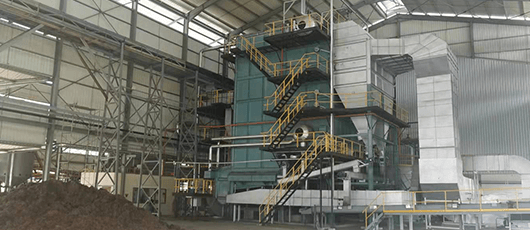
The boiler is the steam source and power source of a factory. The high-pressure and high-temperature steam generated by the biomass boiler using palm fruit as fuel is provided by the back-pressure steam turbine generator. The discharged steam is used to provide heat source in the production process, realizing biomass reuse, power self-sufficiency, and steam self-sufficiency, reducing the production cost of the factory and improving the environmental protection effect. Main equipment: biomass steam boiler, fuel bunker, deaerator, boiler feed water tank, fuel scraper conveyor.
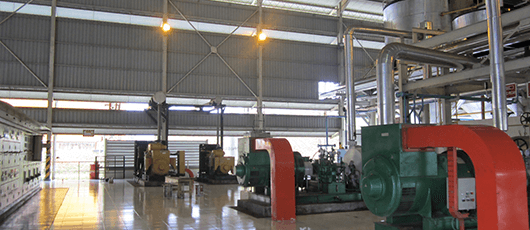
The power room provides power output for the factory. Emergency power uses diesel generator sets, and production power uses steam turbine generator sets, and the two can be switched. Main equipment: steam-water separator, steam turbine generator set, steam separator, diesel generator set, diesel storage tank.
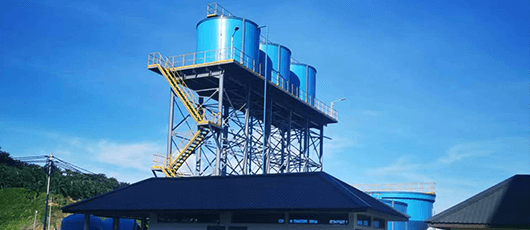
production water is introduced from nearby rivers to the reservoir. After water purification, it is filtered, dosing, clarified, softened, and RO system before being provided to production, boiler water, fire water, and domestic water.
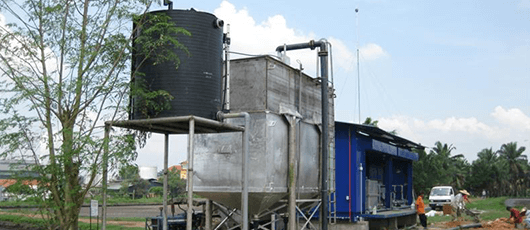
The sewage generated by the palm oil factory contains many harmful substances and recyclable oil. After condensation and sedimentation, the upper oil layer of the discharged sewage is recovered, and the bottom sewage BOD, COD, solid suspended matter SS, etc. are high. Through aerobic, anaerobic, aeration, filter press, filtration, chemical treatment, etc., the sewage meets the government's emission standards.
Main equipment: pump, belt filter press, aerator, MBR water treatment system.

The fresh palm fruit bunches entering the factory are weighed together with the transport vehicles. After unloading, the empty vehicles are weighed again to calculate the net weight of the materials. Main equipment: truck scale and weighing identification calculation system. The fresh palm fruit bunches entering the factory are weighed together with the transport vehicles. After unloading, the empty vehicles are weighed again to calculate the net weight of the materials. Main equipment: truck scale and weighing identification calculation system. The fresh palm fruit bunches entering the factory are weighed together with the transport vehicles. After unloading, the empty vehicles are weighed again to calculate the net weight of the materials. Main equipment: truck scale and weighing identification calculation system. The fresh palm fruit bunches entering the factory are weighed together with the transport vehicles. After unloading, the empty vehicles are weighed again to calculate the net weight of the materials. Main equipment: truck scale and weighing identification calculation system. The fresh palm fruit bunches entering the factory are weighed together with the transport vehicles. After unloading, the empty vehicles are weighed again to calculate the net weight of the materials. Main equipment: truck scale and weighing identification calculation system. The fresh palm fruit bunches entering the factory are weighed together with the transport vehicles. After unloading, the empty vehicles are weighed again to calculate the net weight of the materials. Main equipment: truck scale and weighing identification calculation system. The fresh palm fruit bunches entering the factory are weighed together with the transport vehicles. After unloading, the empty vehicles are weighed again to calculate the net weight of the materials. Main equipment: truck scale and weighing identification calculation system. The fresh palm fruit bunches entering the factory are weighed together with the transport vehicles. After unloading, the empty vehicles are weighed again to calculate the net weight of the materials. Main equipment: truck scale and weighing identification calculation system. The fresh palm fruit bunches entering the factory are weighed together with the transport vehicles. After unloading, the empty vehicles are weighed again to calculate the net weight of the materials. Main equipment: truck scale and weighing identification calculation system.

The fresh fruit bunches after unloading are first sorted manually, and the stones, spoiled fruits and debris that do not meet the requirements are cleaned up. These debris will be sent back and deducted from the weight. At the same time, it also ensures that the equipment is not damaged and improves the quality of the oil. The sorted fresh fruit bunches are stacked on the inclined slope by the loader, and enter the fresh fruit bunch conveying scraper through the opening of the hydraulic device door. Main equipment: unloading platform, unloading slope, hydraulic gate, palm fresh fruit bunch scraper conveyor. The fresh fruit bunches after unloading are first sorted manually, and the stones, spoiled fruits and debris that do not meet the requirements are cleaned up. These debris will be sent back and deducted from the weight. At the same time, it also ensures that the equipment is not damaged and improves the quality of the oil. The sorted fresh fruit bunches are stacked on the inclined slope by the loader, and enter the fresh fruit bunch conveying scraper through the opening of the hydraulic device door. Main equipment: unloading platform, unloading slope, hydraulic gate, palm fresh fruit bunch scraper conveyor. The fresh fruit bunches after unloading are first sorted manually, and the stones, spoiled fruits and debris that do not meet the requirements are cleaned up. These debris will be sent back and deducted from the weight. At the same time, it also ensures that the equipment is not damaged and improves the quality of the oil. The sorted fresh fruit bunches are stacked on the inclined slope by the loader, and enter the fresh fruit bunch conveying scraper through the opening of the hydraulic device door. Main equipment: unloading platform, unloading slope, hydraulic gate, palm fresh fruit bunch scraper conveyor. The fresh fruit bunches after unloading are first sorted manually, and the stones, spoiled fruits and debris that do not meet the requirements are cleaned up. These debris will be sent back and deducted from the weight. At the same time, it also ensures that the equipment is not damaged and improves the quality of the oil. The sorted fresh fruit bunches are stacked on the inclined slope by the loader, and enter the fresh fruit bunch conveying scraper through the opening of the hydraulic device door. Main equipment: unloading platform, unloading slope, hydraulic gate, palm fresh fruit bunch scraper conveyor. The fresh fruit bunches after unloading are first sorted manually, and the stones, spoiled fruits and debris that do not meet the requirements are cleaned up. These debris will be sent back and deducted from the weight. At the same time, it also ensures that the equipment is not damaged and improves the quality of the oil. The sorted fresh fruit bunches are stacked on the inclined slope by the loader, and enter the fresh fruit bunch conveying scraper through the opening of the hydraulic device door. Main equipment: unloading platform, unloading slope, hydraulic gate, palm fresh fruit bunch scraper conveyor. The fresh fruit bunches after unloading are first sorted manually, and the stones, spoiled fruits and debris that do not meet the requirements are cleaned up. These debris will be sent back and deducted from the weight. At the same time, it also ensures that the equipment is not damaged and improves the quality of the oil. The sorted fresh fruit bunches are stacked on the inclined slope by the loader, and enter the fresh fruit bunch conveying scraper through the opening of the hydraulic device door. Main equipment: unloading platform, unloading slope, hydraulic gate, palm fresh fruit bunch scraper conveyor. The fresh fruit bunches after unloading are first sorted manually, and the stones, spoiled fruits and debris that do not meet the requirements are cleaned up. These debris will be sent back and deducted from the weight. At the same time, it also ensures that the equipment is not damaged and improves the quality of the oil. The sorted fresh fruit bunches are stacked on the inclined slope by the loader, and enter the fresh fruit bunch conveying scraper through the opening of the hydraulic device door. Main equipment: unloading platform, unloading slope, hydraulic gate, palm fresh fruit bunch scraper conveyor. The fresh fruit bunches after unloading are first sorted manually, and the stones, spoiled fruits and debris that do not meet the requirements are cleaned up. These debris will be sent back and deducted from the weight. At the same time, it also ensures that the equipment is not damaged and improves the quality of the oil. The sorted fresh fruit bunches are stacked on the inclined slope by the loader, and enter the fresh fruit bunch conveying scraper through the opening of the hydraulic device door. Main equipment: unloading platform, unloading slope, hydraulic gate, palm fresh fruit bunch scraper conveyor. The fresh fruit bunches after unloading are first sorted manually, and the stones, spoiled fruits and debris that do not meet the requirements are cleaned up. These debris will be sent back and deducted from the weight. At the same time, it also ensures that the equipment is not damaged and improves the quality of the oil. The sorted fresh fruit bunches are stacked on the inclined slope by the loader, and enter the fresh fruit bunch conveying scraper through the opening of the hydraulic device door. Main equipment: unloading platform, unloading slope, hydraulic gate, palm fresh fruit bunch scraper conveyor.

Fresh palm fruit bunches are loaded into the sterilization tank by the scraper conveyor and cooked for 80-90 minutes under high temperature 145℃ steam conditions, thereby reducing the activity of enzymes and inhibiting the increase of free fatty acids (FFA). The quality of palm crude oil is guaranteed and conditions for subsequent processes are provided. The main equipment includes: fresh fruit bunch scraper conveyor, sterilization tank, Indexer control system, and cage tipping car.Fresh palm fruit bunches are loaded into the sterilization tank by the scraper conveyor and cooked for 80-90 minutes under high temperature 145℃ steam conditions, thereby reducing the activity of enzymes and inhibiting the increase of free fatty acids (FFA). The quality of palm crude oil is guaranteed and conditions for subsequent processes are provided. The main equipment includes: fresh fruit bunch scraper conveyor, sterilization tank, Indexer control system, and cage tipping car.Fresh palm fruit bunches are loaded into the sterilization tank by the scraper conveyor and cooked for 80-90 minutes under high temperature 145℃ steam conditions, thereby reducing the activity of enzymes and inhibiting the increase of free fatty acids (FFA). The quality of palm crude oil is guaranteed and conditions for subsequent processes are provided. The main equipment includes: fresh fruit bunch scraper conveyor, sterilization tank, Indexer control system, and cage tipping car.Fresh palm fruit bunches are loaded into the sterilization tank by the scraper conveyor and cooked for 80-90 minutes under high temperature 145℃ steam conditions, thereby reducing the activity of enzymes and inhibiting the increase of free fatty acids (FFA). The quality of palm crude oil is guaranteed and conditions for subsequent processes are provided. The main equipment includes: fresh fruit bunch scraper conveyor, sterilization tank, Indexer control system, and cage tipping car.Fresh palm fruit bunches are loaded into the sterilization tank by the scraper conveyor and cooked for 80-90 minutes under high temperature 145℃ steam conditions, thereby reducing the activity of enzymes and inhibiting the increase of free fatty acids (FFA). The quality of palm crude oil is guaranteed and conditions for subsequent processes are provided. The main equipment includes: fresh fruit bunch scraper conveyor, sterilization tank, Indexer control system, and cage tipping car.Fresh palm fruit bunches are loaded into the sterilization tank by the scraper conveyor and cooked for 80-90 minutes under high temperature 145℃ steam conditions, thereby reducing the activity of enzymes and inhibiting the increase of free fatty acids (FFA). The quality of palm crude oil is guaranteed and conditions for subsequent processes are provided. The main equipment includes: fresh fruit bunch scraper conveyor, sterilization tank, Indexer control system, and cage tipping car.Fresh palm fruit bunches are loaded into the sterilization tank by the scraper conveyor and cooked for 80-90 minutes under high temperature 145℃ steam conditions, thereby reducing the activity of enzymes and inhibiting the increase of free fatty acids (FFA). The quality of palm crude oil is guaranteed and conditions for subsequent processes are provided. The main equipment includes: fresh fruit bunch scraper conveyor, sterilization tank, Indexer control system, and cage tipping car.Fresh palm fruit bunches are loaded into the sterilization tank by the scraper conveyor and cooked for 80-90 minutes under high temperature 145℃ steam conditions, thereby reducing the activity of enzymes and inhibiting the increase of free fatty acids (FFA). The quality of palm crude oil is guaranteed and conditions for subsequent processes are provided. The main equipment includes: fresh fruit bunch scraper conveyor, sterilization tank, Indexer control system, and cage tipping car.Fresh palm fruit bunches are loaded into the sterilization tank by the scraper conveyor and cooked for 80-90 minutes under high temperature 145℃ steam conditions, thereby reducing the activity of enzymes and inhibiting the increase of free fatty acids (FFA). The quality of palm crude oil is guaranteed and conditions for subsequent processes are provided. The main equipment includes: fresh fruit bunch scraper conveyor, sterilization tank, Indexer control system, and cage tipping car.

The cooked fruit bunches (SFB) after steaming and sterilization are separated from the palm fruit and empty fruit bunches by drum-type rotary beating.
The empty fruit bunches contain a certain amount of oil and water, which are reduced in water content and residual oil after passing through the empty fruit bunch shredder and empty fruit bunch press. After the size and water content of the empty fruit bunches are reduced, they are transported to the boiler as fuel. Main equipment: empty fruit bunch scraper conveyor, palm fruit threshing machine, empty fruit bunch scraper conveyor, empty fruit bunch shredder, empty fruit bunch press, and rotary vibrating screen.The cooked fruit bunches (SFB) after steaming and sterilization are separated from the palm fruit and empty fruit bunches by drum-type rotary beating.
The empty fruit bunches contain a certain amount of oil and water, which are reduced in water content and residual oil after passing through the empty fruit bunch shredder and empty fruit bunch press. After the size and water content of the empty fruit bunches are reduced, they are transported to the boiler as fuel. Main equipment: empty fruit bunch scraper conveyor, palm fruit threshing machine, empty fruit bunch scraper conveyor, empty fruit bunch shredder, empty fruit bunch press, and rotary vibrating screen.The cooked fruit bunches (SFB) after steaming and sterilization are separated from the palm fruit and empty fruit bunches by drum-type rotary beating.
The empty fruit bunches contain a certain amount of oil and water, which are reduced in water content and residual oil after passing through the empty fruit bunch shredder and empty fruit bunch press. After the size and water content of the empty fruit bunches are reduced, they are transported to the boiler as fuel. Main equipment: empty fruit bunch scraper conveyor, palm fruit threshing machine, empty fruit bunch scraper conveyor, empty fruit bunch shredder, empty fruit bunch press, and rotary vibrating screen.The cooked fruit bunches (SFB) after steaming and sterilization are separated from the palm fruit and empty fruit bunches by drum-type rotary beating.
The empty fruit bunches contain a certain amount of oil and water, which are reduced in water content and residual oil after passing through the empty fruit bunch shredder and empty fruit bunch press. After the size and water content of the empty fruit bunches are reduced, they are transported to the boiler as fuel. Main equipment: empty fruit bunch scraper conveyor, palm fruit threshing machine, empty fruit bunch scraper conveyor, empty fruit bunch shredder, empty fruit bunch press, and rotary vibrating screen.The cooked fruit bunches (SFB) after steaming and sterilization are separated from the palm fruit and empty fruit bunches by drum-type rotary beating.
The empty fruit bunches contain a certain amount of oil and water, which are reduced in water content and residual oil after passing through the empty fruit bunch shredder and empty fruit bunch press. After the size and water content of the empty fruit bunches are reduced, they are transported to the boiler as fuel. Main equipment: empty fruit bunch scraper conveyor, palm fruit threshing machine, empty fruit bunch scraper conveyor, empty fruit bunch shredder, empty fruit bunch press, and rotary vibrating screen.The cooked fruit bunches (SFB) after steaming and sterilization are separated from the palm fruit and empty fruit bunches by drum-type rotary beating.
The empty fruit bunches contain a certain amount of oil and water, which are reduced in water content and residual oil after passing through the empty fruit bunch shredder and empty fruit bunch press. After the size and water content of the empty fruit bunches are reduced, they are transported to the boiler as fuel. Main equipment: empty fruit bunch scraper conveyor, palm fruit threshing machine, empty fruit bunch scraper conveyor, empty fruit bunch shredder, empty fruit bunch press, and rotary vibrating screen.The cooked fruit bunches (SFB) after steaming and sterilization are separated from the palm fruit and empty fruit bunches by drum-type rotary beating.
The empty fruit bunches contain a certain amount of oil and water, which are reduced in water content and residual oil after passing through the empty fruit bunch shredder and empty fruit bunch press. After the size and water content of the empty fruit bunches are reduced, they are transported to the boiler as fuel. Main equipment: empty fruit bunch scraper conveyor, palm fruit threshing machine, empty fruit bunch scraper conveyor, empty fruit bunch shredder, empty fruit bunch press, and rotary vibrating screen.The cooked fruit bunches (SFB) after steaming and sterilization are separated from the palm fruit and empty fruit bunches by drum-type rotary beating.
The empty fruit bunches contain a certain amount of oil and water, which are reduced in water content and residual oil after passing through the empty fruit bunch shredder and empty fruit bunch press. After the size and water content of the empty fruit bunches are reduced, they are transported to the boiler as fuel. Main equipment: empty fruit bunch scraper conveyor, palm fruit threshing machine, empty fruit bunch scraper conveyor, empty fruit bunch shredder, empty fruit bunch press, and rotary vibrating screen.The cooked fruit bunches (SFB) after steaming and sterilization are separated from the palm fruit and empty fruit bunches by drum-type rotary beating.
The empty fruit bunches contain a certain amount of oil and water, which are reduced in water content and residual oil after passing through the empty fruit bunch shredder and empty fruit bunch press. After the size and water content of the empty fruit bunches are reduced, they are transported to the boiler as fuel. Main equipment: empty fruit bunch scraper conveyor, palm fruit threshing machine, empty fruit bunch scraper conveyor, empty fruit bunch shredder, empty fruit bunch press, and rotary vibrating screen.

After sterilization and de-fruiting, the fruit particles enter the crushing tank, where the fruit particles are stirred and crushed into a paste state, and steam is used for sterilization at the same time. Then they enter the double-screw press for extrusion, the oil and water are squeezed out, and the pressed cake including the palm kernel and pulp fiber is separated and crushed and spirally conveyed to the next section. Main equipment: screw conveyor, crushing tank, double-screw press, spiral crusher.After sterilization and de-fruiting, the fruit particles enter the crushing tank, where the fruit particles are stirred and crushed into a paste state, and steam is used for sterilization at the same time. Then they enter the double-screw press for extrusion, the oil and water are squeezed out, and the pressed cake including the palm kernel and pulp fiber is separated and crushed and spirally conveyed to the next section. Main equipment: screw conveyor, crushing tank, double-screw press, spiral crusher.After sterilization and de-fruiting, the fruit particles enter the crushing tank, where the fruit particles are stirred and crushed into a paste state, and steam is used for sterilization at the same time. Then they enter the double-screw press for extrusion, the oil and water are squeezed out, and the pressed cake including the palm kernel and pulp fiber is separated and crushed and spirally conveyed to the next section. Main equipment: screw conveyor, crushing tank, double-screw press, spiral crusher.After sterilization and de-fruiting, the fruit particles enter the crushing tank, where the fruit particles are stirred and crushed into a paste state, and steam is used for sterilization at the same time. Then they enter the double-screw press for extrusion, the oil and water are squeezed out, and the pressed cake including the palm kernel and pulp fiber is separated and crushed and spirally conveyed to the next section. Main equipment: screw conveyor, crushing tank, double-screw press, spiral crusher.After sterilization and de-fruiting, the fruit particles enter the crushing tank, where the fruit particles are stirred and crushed into a paste state, and steam is used for sterilization at the same time. Then they enter the double-screw press for extrusion, the oil and water are squeezed out, and the pressed cake including the palm kernel and pulp fiber is separated and crushed and spirally conveyed to the next section. Main equipment: screw conveyor, crushing tank, double-screw press, spiral crusher.After sterilization and de-fruiting, the fruit particles enter the crushing tank, where the fruit particles are stirred and crushed into a paste state, and steam is used for sterilization at the same time. Then they enter the double-screw press for extrusion, the oil and water are squeezed out, and the pressed cake including the palm kernel and pulp fiber is separated and crushed and spirally conveyed to the next section. Main equipment: screw conveyor, crushing tank, double-screw press, spiral crusher.After sterilization and de-fruiting, the fruit particles enter the crushing tank, where the fruit particles are stirred and crushed into a paste state, and steam is used for sterilization at the same time. Then they enter the double-screw press for extrusion, the oil and water are squeezed out, and the pressed cake including the palm kernel and pulp fiber is separated and crushed and spirally conveyed to the next section. Main equipment: screw conveyor, crushing tank, double-screw press, spiral crusher.After sterilization and de-fruiting, the fruit particles enter the crushing tank, where the fruit particles are stirred and crushed into a paste state, and steam is used for sterilization at the same time. Then they enter the double-screw press for extrusion, the oil and water are squeezed out, and the pressed cake including the palm kernel and pulp fiber is separated and crushed and spirally conveyed to the next section. Main equipment: screw conveyor, crushing tank, double-screw press, spiral crusher.After sterilization and de-fruiting, the fruit particles enter the crushing tank, where the fruit particles are stirred and crushed into a paste state, and steam is used for sterilization at the same time. Then they enter the double-screw press for extrusion, the oil and water are squeezed out, and the pressed cake including the palm kernel and pulp fiber is separated and crushed and spirally conveyed to the next section. Main equipment: screw conveyor, crushing tank, double-screw press, spiral crusher.

The oil clarification station is to reduce the moisture and impurities in the crude oil after pressing, so that its quality meets the market sales standard. After pressing, the crude oil is filtered, settled, sanded, centrifuged, vacuum dried and other processes to remove moisture and impurities in the palm crude oil. The main equipment includes sand settling tank, double-layer rotary vibrating screen, continuous vertical oil clarification tank, sand clarifier, three-phase horizontal screw centrifuge, disc centrifuge, vacuum dryer, etc.The oil clarification station is to reduce the moisture and impurities in the crude oil after pressing, so that its quality meets the market sales standard. After pressing, the crude oil is filtered, settled, sanded, centrifuged, vacuum dried and other processes to remove moisture and impurities in the palm crude oil. The main equipment includes sand settling tank, double-layer rotary vibrating screen, continuous vertical oil clarification tank, sand clarifier, three-phase horizontal screw centrifuge, disc centrifuge, vacuum dryer, etc.The oil clarification station is to reduce the moisture and impurities in the crude oil after pressing, so that its quality meets the market sales standard. After pressing, the crude oil is filtered, settled, sanded, centrifuged, vacuum dried and other processes to remove moisture and impurities in the palm crude oil. The main equipment includes sand settling tank, double-layer rotary vibrating screen, continuous vertical oil clarification tank, sand clarifier, three-phase horizontal screw centrifuge, disc centrifuge, vacuum dryer, etc.The oil clarification station is to reduce the moisture and impurities in the crude oil after pressing, so that its quality meets the market sales standard. After pressing, the crude oil is filtered, settled, sanded, centrifuged, vacuum dried and other processes to remove moisture and impurities in the palm crude oil. The main equipment includes sand settling tank, double-layer rotary vibrating screen, continuous vertical oil clarification tank, sand clarifier, three-phase horizontal screw centrifuge, disc centrifuge, vacuum dryer, etc.The oil clarification station is to reduce the moisture and impurities in the crude oil after pressing, so that its quality meets the market sales standard. After pressing, the crude oil is filtered, settled, sanded, centrifuged, vacuum dried and other processes to remove moisture and impurities in the palm crude oil. The main equipment includes sand settling tank, double-layer rotary vibrating screen, continuous vertical oil clarification tank, sand clarifier, three-phase horizontal screw centrifuge, disc centrifuge, vacuum dryer, etc.The oil clarification station is to reduce the moisture and impurities in the crude oil after pressing, so that its quality meets the market sales standard. After pressing, the crude oil is filtered, settled, sanded, centrifuged, vacuum dried and other processes to remove moisture and impurities in the palm crude oil. The main equipment includes sand settling tank, double-layer rotary vibrating screen, continuous vertical oil clarification tank, sand clarifier, three-phase horizontal screw centrifuge, disc centrifuge, vacuum dryer, etc.The oil clarification station is to reduce the moisture and impurities in the crude oil after pressing, so that its quality meets the market sales standard. After pressing, the crude oil is filtered, settled, sanded, centrifuged, vacuum dried and other processes to remove moisture and impurities in the palm crude oil. The main equipment includes sand settling tank, double-layer rotary vibrating screen, continuous vertical oil clarification tank, sand clarifier, three-phase horizontal screw centrifuge, disc centrifuge, vacuum dryer, etc.The oil clarification station is to reduce the moisture and impurities in the crude oil after pressing, so that its quality meets the market sales standard. After pressing, the crude oil is filtered, settled, sanded, centrifuged, vacuum dried and other processes to remove moisture and impurities in the palm crude oil. The main equipment includes sand settling tank, double-layer rotary vibrating screen, continuous vertical oil clarification tank, sand clarifier, three-phase horizontal screw centrifuge, disc centrifuge, vacuum dryer, etc.The oil clarification station is to reduce the moisture and impurities in the crude oil after pressing, so that its quality meets the market sales standard. After pressing, the crude oil is filtered, settled, sanded, centrifuged, vacuum dried and other processes to remove moisture and impurities in the palm crude oil. The main equipment includes sand settling tank, double-layer rotary vibrating screen, continuous vertical oil clarification tank, sand clarifier, three-phase horizontal screw centrifuge, disc centrifuge, vacuum dryer, etc.

The fiber in the pressed cake is separated and removed, and the kernel shell after the palm kernel is crushed is separated and stored.
The fiber of the cake from the double screw oil press is separated by wind, and the palm kernel is polished, de-stoned, crushed, air-selected, washed and separated to separate the palm kernel and palm shell. The palm kernel and palm shell are dried and stored, and the fiber part is transported to the boiler fuel bunker as boiler fuel. Main equipment: fiber sachets, polishing drums, de-stone separation columns, 1,2-level kernel and shell separation columns, water-washed sachets, kernel drying bunkers, kernel and shell screw conveyors and elevators.The fiber in the pressed cake is separated and removed, and the kernel shell after the palm kernel is crushed is separated and stored.
The fiber of the cake from the double screw oil press is separated by wind, and the palm kernel is polished, de-stoned, crushed, air-selected, washed and separated to separate the palm kernel and palm shell. The palm kernel and palm shell are dried and stored, and the fiber part is transported to the boiler fuel bunker as boiler fuel. Main equipment: fiber sachets, polishing drums, de-stone separation columns, 1,2-level kernel and shell separation columns, water-washed sachets, kernel drying bunkers, kernel and shell screw conveyors and elevators.The fiber in the pressed cake is separated and removed, and the kernel shell after the palm kernel is crushed is separated and stored.
The fiber of the cake from the double screw oil press is separated by wind, and the palm kernel is polished, de-stoned, crushed, air-selected, washed and separated to separate the palm kernel and palm shell. The palm kernel and palm shell are dried and stored, and the fiber part is transported to the boiler fuel bunker as boiler fuel. Main equipment: fiber sachets, polishing drums, de-stone separation columns, 1,2-level kernel and shell separation columns, water-washed sachets, kernel drying bunkers, kernel and shell screw conveyors and elevators.The fiber in the pressed cake is separated and removed, and the kernel shell after the palm kernel is crushed is separated and stored.
The fiber of the cake from the double screw oil press is separated by wind, and the palm kernel is polished, de-stoned, crushed, air-selected, washed and separated to separate the palm kernel and palm shell. The palm kernel and palm shell are dried and stored, and the fiber part is transported to the boiler fuel bunker as boiler fuel. Main equipment: fiber sachets, polishing drums, de-stone separation columns, 1,2-level kernel and shell separation columns, water-washed sachets, kernel drying bunkers, kernel and shell screw conveyors and elevators.The fiber in the pressed cake is separated and removed, and the kernel shell after the palm kernel is crushed is separated and stored.
The fiber of the cake from the double screw oil press is separated by wind, and the palm kernel is polished, de-stoned, crushed, air-selected, washed and separated to separate the palm kernel and palm shell. The palm kernel and palm shell are dried and stored, and the fiber part is transported to the boiler fuel bunker as boiler fuel. Main equipment: fiber sachets, polishing drums, de-stone separation columns, 1,2-level kernel and shell separation columns, water-washed sachets, kernel drying bunkers, kernel and shell screw conveyors and elevators.The fiber in the pressed cake is separated and removed, and the kernel shell after the palm kernel is crushed is separated and stored.
The fiber of the cake from the double screw oil press is separated by wind, and the palm kernel is polished, de-stoned, crushed, air-selected, washed and separated to separate the palm kernel and palm shell. The palm kernel and palm shell are dried and stored, and the fiber part is transported to the boiler fuel bunker as boiler fuel. Main equipment: fiber sachets, polishing drums, de-stone separation columns, 1,2-level kernel and shell separation columns, water-washed sachets, kernel drying bunkers, kernel and shell screw conveyors and elevators.The fiber in the pressed cake is separated and removed, and the kernel shell after the palm kernel is crushed is separated and stored.
The fiber of the cake from the double screw oil press is separated by wind, and the palm kernel is polished, de-stoned, crushed, air-selected, washed and separated to separate the palm kernel and palm shell. The palm kernel and palm shell are dried and stored, and the fiber part is transported to the boiler fuel bunker as boiler fuel. Main equipment: fiber sachets, polishing drums, de-stone separation columns, 1,2-level kernel and shell separation columns, water-washed sachets, kernel drying bunkers, kernel and shell screw conveyors and elevators.The fiber in the pressed cake is separated and removed, and the kernel shell after the palm kernel is crushed is separated and stored.
The fiber of the cake from the double screw oil press is separated by wind, and the palm kernel is polished, de-stoned, crushed, air-selected, washed and separated to separate the palm kernel and palm shell. The palm kernel and palm shell are dried and stored, and the fiber part is transported to the boiler fuel bunker as boiler fuel. Main equipment: fiber sachets, polishing drums, de-stone separation columns, 1,2-level kernel and shell separation columns, water-washed sachets, kernel drying bunkers, kernel and shell screw conveyors and elevators.The fiber in the pressed cake is separated and removed, and the kernel shell after the palm kernel is crushed is separated and stored.
The fiber of the cake from the double screw oil press is separated by wind, and the palm kernel is polished, de-stoned, crushed, air-selected, washed and separated to separate the palm kernel and palm shell. The palm kernel and palm shell are dried and stored, and the fiber part is transported to the boiler fuel bunker as boiler fuel. Main equipment: fiber sachets, polishing drums, de-stone separation columns, 1,2-level kernel and shell separation columns, water-washed sachets, kernel drying bunkers, kernel and shell screw conveyors and elevators.

The boiler is the steam source and power source of a factory. The high-pressure and high-temperature steam generated by the biomass boiler using palm fruit as fuel is provided by the back-pressure steam turbine generator. The discharged steam is used to provide heat source in the production process, realizing biomass reuse, power self-sufficiency, and steam self-sufficiency, reducing the production cost of the factory and improving the environmental protection effect. Main equipment: biomass steam boiler, fuel bunker, deaerator, boiler feed water tank, fuel scraper conveyor.The boiler is the steam source and power source of a factory. The high-pressure and high-temperature steam generated by the biomass boiler using palm fruit as fuel is provided by the back-pressure steam turbine generator. The discharged steam is used to provide heat source in the production process, realizing biomass reuse, power self-sufficiency, and steam self-sufficiency, reducing the production cost of the factory and improving the environmental protection effect. Main equipment: biomass steam boiler, fuel bunker, deaerator, boiler feed water tank, fuel scraper conveyor.The boiler is the steam source and power source of a factory. The high-pressure and high-temperature steam generated by the biomass boiler using palm fruit as fuel is provided by the back-pressure steam turbine generator. The discharged steam is used to provide heat source in the production process, realizing biomass reuse, power self-sufficiency, and steam self-sufficiency, reducing the production cost of the factory and improving the environmental protection effect. Main equipment: biomass steam boiler, fuel bunker, deaerator, boiler feed water tank, fuel scraper conveyor.The boiler is the steam source and power source of a factory. The high-pressure and high-temperature steam generated by the biomass boiler using palm fruit as fuel is provided by the back-pressure steam turbine generator. The discharged steam is used to provide heat source in the production process, realizing biomass reuse, power self-sufficiency, and steam self-sufficiency, reducing the production cost of the factory and improving the environmental protection effect. Main equipment: biomass steam boiler, fuel bunker, deaerator, boiler feed water tank, fuel scraper conveyor.The boiler is the steam source and power source of a factory. The high-pressure and high-temperature steam generated by the biomass boiler using palm fruit as fuel is provided by the back-pressure steam turbine generator. The discharged steam is used to provide heat source in the production process, realizing biomass reuse, power self-sufficiency, and steam self-sufficiency, reducing the production cost of the factory and improving the environmental protection effect. Main equipment: biomass steam boiler, fuel bunker, deaerator, boiler feed water tank, fuel scraper conveyor.The boiler is the steam source and power source of a factory. The high-pressure and high-temperature steam generated by the biomass boiler using palm fruit as fuel is provided by the back-pressure steam turbine generator. The discharged steam is used to provide heat source in the production process, realizing biomass reuse, power self-sufficiency, and steam self-sufficiency, reducing the production cost of the factory and improving the environmental protection effect. Main equipment: biomass steam boiler, fuel bunker, deaerator, boiler feed water tank, fuel scraper conveyor.The boiler is the steam source and power source of a factory. The high-pressure and high-temperature steam generated by the biomass boiler using palm fruit as fuel is provided by the back-pressure steam turbine generator. The discharged steam is used to provide heat source in the production process, realizing biomass reuse, power self-sufficiency, and steam self-sufficiency, reducing the production cost of the factory and improving the environmental protection effect. Main equipment: biomass steam boiler, fuel bunker, deaerator, boiler feed water tank, fuel scraper conveyor.The boiler is the steam source and power source of a factory. The high-pressure and high-temperature steam generated by the biomass boiler using palm fruit as fuel is provided by the back-pressure steam turbine generator. The discharged steam is used to provide heat source in the production process, realizing biomass reuse, power self-sufficiency, and steam self-sufficiency, reducing the production cost of the factory and improving the environmental protection effect. Main equipment: biomass steam boiler, fuel bunker, deaerator, boiler feed water tank, fuel scraper conveyor.The boiler is the steam source and power source of a factory. The high-pressure and high-temperature steam generated by the biomass boiler using palm fruit as fuel is provided by the back-pressure steam turbine generator. The discharged steam is used to provide heat source in the production process, realizing biomass reuse, power self-sufficiency, and steam self-sufficiency, reducing the production cost of the factory and improving the environmental protection effect. Main equipment: biomass steam boiler, fuel bunker, deaerator, boiler feed water tank, fuel scraper conveyor.

The power room provides power output for the factory. Emergency power uses diesel generator sets, and production power uses steam turbine generator sets, and the two can be switched. Main equipment: steam-water separator, steam turbine generator set, steam separator, diesel generator set, diesel storage tank.The power room provides power output for the factory. Emergency power uses diesel generator sets, and production power uses steam turbine generator sets, and the two can be switched. Main equipment: steam-water separator, steam turbine generator set, steam separator, diesel generator set, diesel storage tank.The power room provides power output for the factory. Emergency power uses diesel generator sets, and production power uses steam turbine generator sets, and the two can be switched. Main equipment: steam-water separator, steam turbine generator set, steam separator, diesel generator set, diesel storage tank.The power room provides power output for the factory. Emergency power uses diesel generator sets, and production power uses steam turbine generator sets, and the two can be switched. Main equipment: steam-water separator, steam turbine generator set, steam separator, diesel generator set, diesel storage tank.The power room provides power output for the factory. Emergency power uses diesel generator sets, and production power uses steam turbine generator sets, and the two can be switched. Main equipment: steam-water separator, steam turbine generator set, steam separator, diesel generator set, diesel storage tank.The power room provides power output for the factory. Emergency power uses diesel generator sets, and production power uses steam turbine generator sets, and the two can be switched. Main equipment: steam-water separator, steam turbine generator set, steam separator, diesel generator set, diesel storage tank.The power room provides power output for the factory. Emergency power uses diesel generator sets, and production power uses steam turbine generator sets, and the two can be switched. Main equipment: steam-water separator, steam turbine generator set, steam separator, diesel generator set, diesel storage tank.The power room provides power output for the factory. Emergency power uses diesel generator sets, and production power uses steam turbine generator sets, and the two can be switched. Main equipment: steam-water separator, steam turbine generator set, steam separator, diesel generator set, diesel storage tank.The power room provides power output for the factory. Emergency power uses diesel generator sets, and production power uses steam turbine generator sets, and the two can be switched. Main equipment: steam-water separator, steam turbine generator set, steam separator, diesel generator set, diesel storage tank.

production water is introduced from nearby rivers to the reservoir. After water purification, it is filtered, dosing, clarified, softened, and RO system before being provided to production, boiler water, fire water, and domestic water.production water is introduced from nearby rivers to the reservoir. After water purification, it is filtered, dosing, clarified, softened, and RO system before being provided to production, boiler water, fire water, and domestic water.production water is introduced from nearby rivers to the reservoir. After water purification, it is filtered, dosing, clarified, softened, and RO system before being provided to production, boiler water, fire water, and domestic water.production water is introduced from nearby rivers to the reservoir. After water purification, it is filtered, dosing, clarified, softened, and RO system before being provided to production, boiler water, fire water, and domestic water.production water is introduced from nearby rivers to the reservoir. After water purification, it is filtered, dosing, clarified, softened, and RO system before being provided to production, boiler water, fire water, and domestic water.production water is introduced from nearby rivers to the reservoir. After water purification, it is filtered, dosing, clarified, softened, and RO system before being provided to production, boiler water, fire water, and domestic water.production water is introduced from nearby rivers to the reservoir. After water purification, it is filtered, dosing, clarified, softened, and RO system before being provided to production, boiler water, fire water, and domestic water.production water is introduced from nearby rivers to the reservoir. After water purification, it is filtered, dosing, clarified, softened, and RO system before being provided to production, boiler water, fire water, and domestic water.production water is introduced from nearby rivers to the reservoir. After water purification, it is filtered, dosing, clarified, softened, and RO system before being provided to production, boiler water, fire water, and domestic water.

The sewage generated by the palm oil factory contains many harmful substances and recyclable oil. After condensation and sedimentation, the upper oil layer of the discharged sewage is recovered, and the bottom sewage BOD, COD, solid suspended matter SS, etc. are high. Through aerobic, anaerobic, aeration, filter press, filtration, chemical treatment, etc., the sewage meets the government's emission standards.
Main equipment: pump, belt filter press, aerator, MBR water treatment system.The sewage generated by the palm oil factory contains many harmful substances and recyclable oil. After condensation and sedimentation, the upper oil layer of the discharged sewage is recovered, and the bottom sewage BOD, COD, solid suspended matter SS, etc. are high. Through aerobic, anaerobic, aeration, filter press, filtration, chemical treatment, etc., the sewage meets the government's emission standards.
Main equipment: pump, belt filter press, aerator, MBR water treatment system.The sewage generated by the palm oil factory contains many harmful substances and recyclable oil. After condensation and sedimentation, the upper oil layer of the discharged sewage is recovered, and the bottom sewage BOD, COD, solid suspended matter SS, etc. are high. Through aerobic, anaerobic, aeration, filter press, filtration, chemical treatment, etc., the sewage meets the government's emission standards.
Main equipment: pump, belt filter press, aerator, MBR water treatment system.The sewage generated by the palm oil factory contains many harmful substances and recyclable oil. After condensation and sedimentation, the upper oil layer of the discharged sewage is recovered, and the bottom sewage BOD, COD, solid suspended matter SS, etc. are high. Through aerobic, anaerobic, aeration, filter press, filtration, chemical treatment, etc., the sewage meets the government's emission standards.
Main equipment: pump, belt filter press, aerator, MBR water treatment system.The sewage generated by the palm oil factory contains many harmful substances and recyclable oil. After condensation and sedimentation, the upper oil layer of the discharged sewage is recovered, and the bottom sewage BOD, COD, solid suspended matter SS, etc. are high. Through aerobic, anaerobic, aeration, filter press, filtration, chemical treatment, etc., the sewage meets the government's emission standards.
Main equipment: pump, belt filter press, aerator, MBR water treatment system.The sewage generated by the palm oil factory contains many harmful substances and recyclable oil. After condensation and sedimentation, the upper oil layer of the discharged sewage is recovered, and the bottom sewage BOD, COD, solid suspended matter SS, etc. are high. Through aerobic, anaerobic, aeration, filter press, filtration, chemical treatment, etc., the sewage meets the government's emission standards.
Main equipment: pump, belt filter press, aerator, MBR water treatment system.The sewage generated by the palm oil factory contains many harmful substances and recyclable oil. After condensation and sedimentation, the upper oil layer of the discharged sewage is recovered, and the bottom sewage BOD, COD, solid suspended matter SS, etc. are high. Through aerobic, anaerobic, aeration, filter press, filtration, chemical treatment, etc., the sewage meets the government's emission standards.
Main equipment: pump, belt filter press, aerator, MBR water treatment system.The sewage generated by the palm oil factory contains many harmful substances and recyclable oil. After condensation and sedimentation, the upper oil layer of the discharged sewage is recovered, and the bottom sewage BOD, COD, solid suspended matter SS, etc. are high. Through aerobic, anaerobic, aeration, filter press, filtration, chemical treatment, etc., the sewage meets the government's emission standards.
Main equipment: pump, belt filter press, aerator, MBR water treatment system.The sewage generated by the palm oil factory contains many harmful substances and recyclable oil. After condensation and sedimentation, the upper oil layer of the discharged sewage is recovered, and the bottom sewage BOD, COD, solid suspended matter SS, etc. are high. Through aerobic, anaerobic, aeration, filter press, filtration, chemical treatment, etc., the sewage meets the government's emission standards.
Main equipment: pump, belt filter press, aerator, MBR water treatment system.
• Low oil yield
• High oil loss 2.5-3%
• Low by-product utilization(EFB,palm shell, POME)
• Oil Recovery Process Treatment
• Reduced oil loss to 0.5-0.8%
• EFB for boiler fuel, palm shell for sale, POME for biogas
• Increased value of CPO outputs
• Increased value of by-product outputs
• Effluent discharge indicators (BOD, COD) reduced
• Reduced production energy costs (EFB for boiler fuel)
| Sports Event | Traditional Equipment | Yahua Equipment |
|---|---|---|
| process design | high oil loss | low oil loss (high oil recovery rate) |
| Equipment quality | high failure rate | low failure rate (high brand configuration and material configuration) |
| electrical configuration | most rely on manual operation | PLC, CCTV automation control |
Modular Process Design,Energy Saving and Environmental Protection Solutions,Improvement of production efficiency
Intelligent digital CNC machining system, perfect supply chain system, rich production management experience
Complete sea, land and air transportation network, remote online data visualization monitoring and diagnosis
Reduced oil losses, increased by-product re-use, power self-sufficiency, green environmental protection
